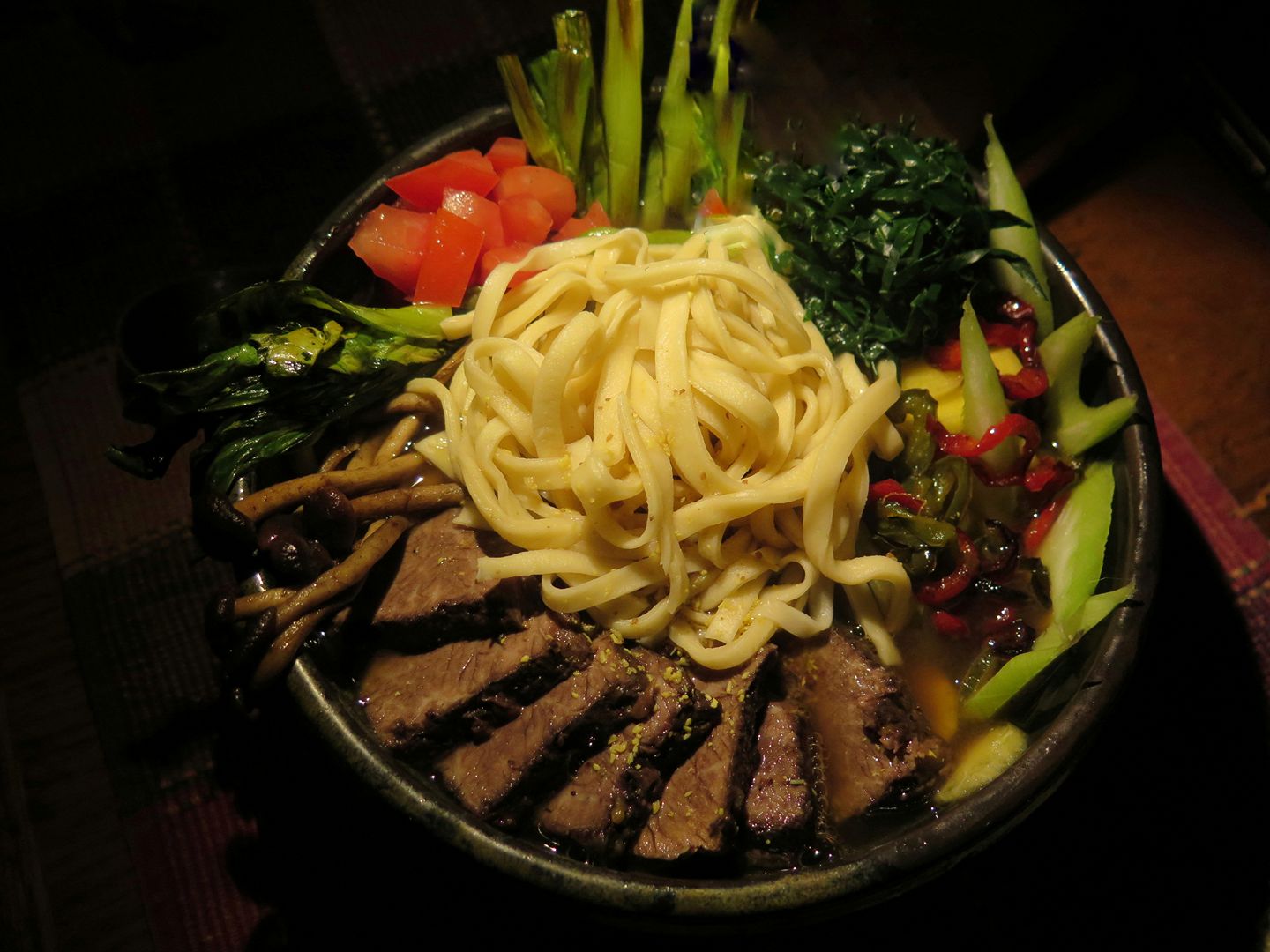I bet at some point you’ve tasted a White Gazpacho or ajo blanco as they call it in Cordoba. It is thick and creamy and made much like red gazpacho, minus the tomatoes – but including bread, olive oil, vinegar and a ton of garlic, maybe egg yolks. It’s garnished with bits of apple and raisins usually. There is a riot of flavors in this soup but it can be utterly delicious. But people tell you it’s the historic ancestor of gazpacho. Well, I don’t think so exactly. Or at least I’ve never seen anything exactly like it in the past. But some things come close. Here’s one that definitely captures 16th century taste preferences: take out the garlic and vinegar, add sugar and rosewater. I know it’s SO unhip nowadays, but I think this comes much closer. And frankly, it is fabulous.
Juan Vallés Regalo de la Vida Humana pp. 623-4
Escudilla de piñonada
Take a good quantity of pine nuts which are well cleaned and white and as much of blanched almonds, and put all together in a stone mortar, moistening the pestle of the mortar with rose water or with broth so it doesn’t oil up, and then being well crushed loosen it with chicken broth and pass through a sieve, and then put it in a clean pot and add to it sugar and cook stirring always with a pestle until it thickens, remove from the fire and leave to rest a little covered with a cloth and over the plates, sprinkle sugar.
Tuesday, August 28, 2012
Wednesday, August 22, 2012
Routledge International Handbook of Food Studies
http://www.routledge.com/books/details/9780415782647/
What do you know? Another book of mine just arrived. Here's what's inside:
Social sciences
1 The anthropology of food - Robert Dirks and Gina Hunter
2 The sociology of food - William Alex McIntosh
3 Food and communication - Arthur Lizie
4 Historical background of food scholarship in psychology and major
theoretical approaches in use - Kima Cargill
5 Nutritional anthropology - Janet Chrzan
6 Public health nutrition - Arlene Spark
7 The archaeology of food - Katherine M. Moore
Humanities
8 Journalism - Helen Rosner and Amanda Hesser
9 The cultural history of food - Deborah Valenze
10 Culinary history - Ken Albala
11 Food and literature: an overview - Joan Fitzpatrick
12 Philosophy and food - Lisa Heldke
13 Linguistics and food studies: structural and historical connections - Anthony F.
Buccini
14 Food and theology - David Grumett
15 Food and art - Travis Nygard
16 Food in film - Anne Bower and Thomas Piontek
17 Food and television - Sarah Murray
Interdisciplinary food studies
18 Food studies programs - Rachel Black
19 Food and American studies - Margot Finn
20 Folklore - Lucy M. Long
21 Food museums - Elizabeth Williams
22 Food and law - Baylen J. Linnekin and Emily Broad Leib
23 The intersection of gender and food studies - Alice McLean
24 Culinary arts and foodservice management - Vivian Liberman and Jonathan Deutsch
25 Food, cultural studies, and popular culture - Fabio Parasecoli
26 Food and race: an overview - Psyche Williams-Forson and Jessica Walker
Special topics in food studies
27 Food justice: an overview - Alison Hope Alkon
28 Food studies and animal rights - Carol Helstosky
29 Qualitative and mixed methods approaches to explore social dimensions of food and
nutrition security - Stefanie Lemke and Anne C. Bellows
30 School food - Janet Poppendieck
31 Food in tourism studies - Lucy M. Long
32 Food and the senses - Beth M. Forrest and Deirdre Murphy
33 Anticipating a new agricultural research agenda for the twenty-first century –
Frederick L. Kirschenmann
34 Food and ethics - Julia Abramson
What do you know? Another book of mine just arrived. Here's what's inside:
Social sciences
1 The anthropology of food - Robert Dirks and Gina Hunter
2 The sociology of food - William Alex McIntosh
3 Food and communication - Arthur Lizie
4 Historical background of food scholarship in psychology and major
theoretical approaches in use - Kima Cargill
5 Nutritional anthropology - Janet Chrzan
6 Public health nutrition - Arlene Spark
7 The archaeology of food - Katherine M. Moore
Humanities
8 Journalism - Helen Rosner and Amanda Hesser
9 The cultural history of food - Deborah Valenze
10 Culinary history - Ken Albala
11 Food and literature: an overview - Joan Fitzpatrick
12 Philosophy and food - Lisa Heldke
13 Linguistics and food studies: structural and historical connections - Anthony F.
Buccini
14 Food and theology - David Grumett
15 Food and art - Travis Nygard
16 Food in film - Anne Bower and Thomas Piontek
17 Food and television - Sarah Murray
Interdisciplinary food studies
18 Food studies programs - Rachel Black
19 Food and American studies - Margot Finn
20 Folklore - Lucy M. Long
21 Food museums - Elizabeth Williams
22 Food and law - Baylen J. Linnekin and Emily Broad Leib
23 The intersection of gender and food studies - Alice McLean
24 Culinary arts and foodservice management - Vivian Liberman and Jonathan Deutsch
25 Food, cultural studies, and popular culture - Fabio Parasecoli
26 Food and race: an overview - Psyche Williams-Forson and Jessica Walker
Special topics in food studies
27 Food justice: an overview - Alison Hope Alkon
28 Food studies and animal rights - Carol Helstosky
29 Qualitative and mixed methods approaches to explore social dimensions of food and
nutrition security - Stefanie Lemke and Anne C. Bellows
30 School food - Janet Poppendieck
31 Food in tourism studies - Lucy M. Long
32 Food and the senses - Beth M. Forrest and Deirdre Murphy
33 Anticipating a new agricultural research agenda for the twenty-first century –
Frederick L. Kirschenmann
34 Food and ethics - Julia Abramson
Wednesday, August 8, 2012
Curing Question
I have a question about curing meat. These are hand chopped pork sausages, made with a lot of paprika and garlic, that were hung to cure for three days at around 60 degrees and then smoked for about an hour somewhere around 120-30 degrees I'm guessing. I could handle them, so they never got very hot, but they're pretty much cooked through. They were delicious then and there and most went into a rice and veg dish, something like a paella. Luscious and smokey.
Here's my question: Can I now hang these and let them dry further? It's only instacure #1 inside, no bacterial starters or anything like that. Does the light cooking affect the cure? That is, will they go bad if I leave them to dry for a few more weeks or will they still be good to eat as a smoked and dried sausage? Or would it have been better to really cold smoke? I'm not talking industrial protocols here. I know this was done in ancient times and they were kept for a long time, but I have no idea what will happen. TKS, K
Here's my question: Can I now hang these and let them dry further? It's only instacure #1 inside, no bacterial starters or anything like that. Does the light cooking affect the cure? That is, will they go bad if I leave them to dry for a few more weeks or will they still be good to eat as a smoked and dried sausage? Or would it have been better to really cold smoke? I'm not talking industrial protocols here. I know this was done in ancient times and they were kept for a long time, but I have no idea what will happen. TKS, K
Monday, August 6, 2012
SUPERCANDY
I haven't had a good rant in a while, so here goes. A few months ago a marketing firm must have collected data on every publication with the word food in it, and assumed these were food and cooking magazines. They then sold this data to every marketing firm in the country who then sold it to every company selling a new food product. As Co-Editor of Food Culture and Society, I am apparently on their radar. It began as a trickle of emails, then soon a deluge. New restaurants, food tourism, everything from gourmet foods to Peeps. (Yes, just this afternoon.) I started by politely explaining that I edit a peer reviewed academic journal. We don't feature new products, have a holiday gift ideas section, or do restaurant reviews. I don't blame anyone for misunderstanding, and most wrote back to me immediately, saying of course, sorry, we'll happily remove you from our mailing list.
A few didn't. A few insisted on offering products even after I'd explained it all. And sometimes it was just too hard to resist. PEEPS? By all means, send me all you like, I will eat them with glee. (You know I will share with you someday the recipe for peep floaters in chicken broth, chili and lime. Delicious.) So after one offer to send samples too many, I just said sure. I'd love to try your new product. That was being honest. And then this morning an envelope appeared containing promotional material and five little packets of candy. (The company selling sardines never send me a dozen cases as requested.)
This is not just any candy, but "supercandy" and it is designed especially for those with healthy active lifestyles who love candy but don't want to eat mass produced junk. OK. It has B vitamins, antioxidants and electrolytes. I am already worried about eating it. And you have to wonder, people who lead active lifestyles can eat candy every now and then without worrying, no? And doesn't it also strike you as oddly oxymoronic? Health-Conscious Candy? So sort of like Probiotic Alcohol. Or Cigarettes for Children? I'd buy those. Regardless, the family was very excited when I brought it home. My wife scrutinized the ingredients and scoffed. (OF which I am very proud - it's still all industrial mass produced crap and vitamins in chemical form.)
But the kids and I tasted it all. From the gummies (not bad) to the caramel (too gooey to be pleasantly chewy) to tarts (which I liked the best - though they did make everything else, even water, taste really sweet) to the beans (salty and revolting like gatorade) to the gum (which tasted like breakfast cereal, froot loops in particular, which makes NO sense to me). None was actually good enough to purchase. I don't know how much they cost, but if I want a sweet tart, that's what I'll eat, once in a blue moon. Likewise gum, more often, but only if it tastes good. As for the rest, is any of the conventional candy that much worse for you that this? If you need vitamins and electrolyte balance, eat fruits and vegetables - maybe even liver for B12. But pharmaceutical candy? I honestly don't get it. And I'm sure it will sell in health food stores, then you'll see it on grocery store shelves. All because people just believe anything. Slap a label on a bag of cheetos saying "this is organic, all natural, probiotic, neutraceutical, functional, fair trade, local with NO glutens" and then people feel good and pay more so they can tell other people they ate it.
At time the imagination strains to comprehend the ways of man.
A few didn't. A few insisted on offering products even after I'd explained it all. And sometimes it was just too hard to resist. PEEPS? By all means, send me all you like, I will eat them with glee. (You know I will share with you someday the recipe for peep floaters in chicken broth, chili and lime. Delicious.) So after one offer to send samples too many, I just said sure. I'd love to try your new product. That was being honest. And then this morning an envelope appeared containing promotional material and five little packets of candy. (The company selling sardines never send me a dozen cases as requested.)
This is not just any candy, but "supercandy" and it is designed especially for those with healthy active lifestyles who love candy but don't want to eat mass produced junk. OK. It has B vitamins, antioxidants and electrolytes. I am already worried about eating it. And you have to wonder, people who lead active lifestyles can eat candy every now and then without worrying, no? And doesn't it also strike you as oddly oxymoronic? Health-Conscious Candy? So sort of like Probiotic Alcohol. Or Cigarettes for Children? I'd buy those. Regardless, the family was very excited when I brought it home. My wife scrutinized the ingredients and scoffed. (OF which I am very proud - it's still all industrial mass produced crap and vitamins in chemical form.)
But the kids and I tasted it all. From the gummies (not bad) to the caramel (too gooey to be pleasantly chewy) to tarts (which I liked the best - though they did make everything else, even water, taste really sweet) to the beans (salty and revolting like gatorade) to the gum (which tasted like breakfast cereal, froot loops in particular, which makes NO sense to me). None was actually good enough to purchase. I don't know how much they cost, but if I want a sweet tart, that's what I'll eat, once in a blue moon. Likewise gum, more often, but only if it tastes good. As for the rest, is any of the conventional candy that much worse for you that this? If you need vitamins and electrolyte balance, eat fruits and vegetables - maybe even liver for B12. But pharmaceutical candy? I honestly don't get it. And I'm sure it will sell in health food stores, then you'll see it on grocery store shelves. All because people just believe anything. Slap a label on a bag of cheetos saying "this is organic, all natural, probiotic, neutraceutical, functional, fair trade, local with NO glutens" and then people feel good and pay more so they can tell other people they ate it.
At time the imagination strains to comprehend the ways of man.
Subscribe to:
Posts (Atom)







